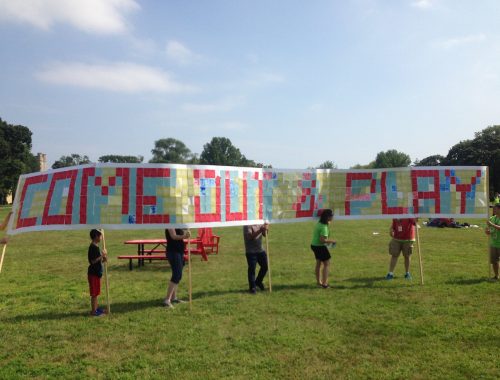July! And here’s some of what’s going on in city play and physical games…
Open Calls
The Interesting Games Lab is back in Bristol, after a long sleep of quite a few years! This is really exciting – Iglab was one of the earliest regular events for games with a big physical component, letting people meet up and playtest and discuss their medium. It’s so fantastic to see it back with a run of events over the latter half of the year. The next Iglab (now run by Free Ice Cream) is on 25 July, or you can submit a game (there’s a selection of themes) for another event in the run.
And in London, Beta Public – a night of performance and videogames – has been announced for 13 November. They don’t have a call for at a bit of info about the event (or book tickets).
Conferences and Talks
On 8 August at the Museum of London, come along for The London Salon: Playing Out. There’ll be four speakers discussing play in the city, including Matt Adams from Blast Theory, and also me (Holly).
Watershed has announced its conference Making the City Playable for 19 October (in Bristol). They have a few confirmed speakers with more to come, and if their events in previous years are anything to go by it’s going to be absolutely fascinating, well worth getting along to if you can make it.
Exhibitions
London-based artist Tine Bech is showing some gorgeous interactive work at 201 Broadgate, with her show Come Into Play.
The Museum of London has a small display about play in city streets called Time to Play. I haven’t seen it yet but it looks like it’s a mix of photographs and objects, and should be well worth a look.
On 7 July (that’s today!), States of Play opened in Hull – a “new Crafts Council exhibition for Hull City of Culture 2017 which shows how play shapes our lives and the world around us”, with sixteen different games including new commissions and a collection of “installations and objects [that] invite us to play – either physically or in our imaginations”. This sounds AMAZING; if anyone’s been already do let me know what it’s like, it might be a few weeks before we can make it along.
Mid-July will also see an exhibition on play at the Freud Museum: “Using storytelling, art works, oral histories and interactive games, this exhibition will explore play and its many meanings in psychoanalysis”.
And there’s what sounds like a brilliant exhibition in Milan until February next year: Giro Giro Tondo: Design for Children. It covers furniture, architecture, games – there’s a reasonably detailed writeup here.
Festivals and Events
12 July sees Games By The Sea return to Brighton – it’s currently fully booked but there’s a waitlist you can add yourself to.
Come Out and Play will be running in New York on 21 and 22 July – its twelfth year as a festival of outdoor play and pervasive games!
We’ve already listed it in Open Calls above, but the Interesting Games Lab returns to Bristol on 25 July! And it’s bound to be a lovely time.
Things to Look At
Artist collective mmmm has done a TON of fascinating stuff, but I’d previously missed their Divided Street (see picture above). “A transparent plastic wall, three meters tall, cuts a pedestrian street into two. You can see what happens on the other side but you cannot cross.”
Here’s a gorgeous tumblr of a photographer’s pictures of Japanese playground equipment.
The City Play Project is an Instagram account documenting city play over the course of a hundred days.
It’s a year old, but if (like us) you missed this Guardian slideshow of prettily painted road crossings it’s definitely worth a browse!
Things to Read
Annie Warburton’s Playmakers is about “the relationship between play and making”, with particular reference to the States of Play exhibition in Hull (see above). Sample sentence: “In this way, playing and making empower us to shape the environment. They are expressions of our agency in the world. This is not to make a trite identification of one with the other: making cannot be reduced to a form of playing.Rather, it is that an experimental mindset, curious about materials, willing to try things out, to explore through trial and error – in short, a playful attitude – characterises many craft practices.”
The architect Helen Fornan has put together a summary of decades of studies about residential street and estate design, and how it affects play (particularly play by children). Her review is available to read here (pdf) or you can get a quick idea of her motivations and process via this blog post at Playing Out. Sample sentence: “Back gardens were much less popular than front gardens. Biddulph (2011) also found that the majority of children observed outside were socialising with others, with very few playing out on their own. “
Entertainment Designer has a look at the history and future of dark rides – non-thrill-based theme park rides where participants move through the space in an enclosed carriage, like a ghost train. It’s really interesting! Sample sentence: “If you look closely at Small World’s scenes, you’ll notice that they seem a little odd by current standards. Some characters seem to be in the wrong places: they’re up too high, or too far behind you when they should be in front. Disney’s original Imagineers were still figuring out how to lay out a ride. They hadn’t fully learned that placing props on the outside of a curve is usually better than putting them on the inside, which makes for an awkward perspective.”




